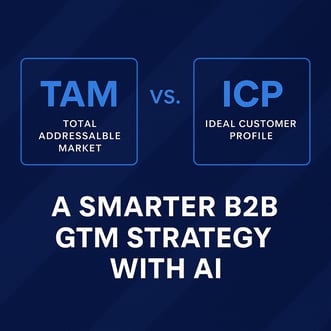You’ve built campaigns, hired SDRs, invested in ABM tech, and still, your pipeline is short.
The uncomfortable truth? Most B2B teams are aiming at the wrong target. They confuse reach with relevance (just because you can target 100,000 accounts doesn’t mean you should). They confuse action with timing (content download ≠ in-market buyer). And they confuse content volume with content authority (posting a bunch of blog posts ≠ trusted expertise). Hitting your number in today’s AI-powered buyer environment doesn’t require more tools, it requires sharper targeting, clearer messaging, and smarter timing.
Focus on:
- Defining your ICP
- Creating buyer personas based on behavior
- Delivering content your buyers are actively seeking
In this post, we challenge the status quo and offer a three-part framework built for modern GTM teams who want to move from busy to effective.
Step 1: Define TAM, ICP, and Intent: Know Where, Who, and When
Let’s start with a hard truth: most teams operate without a shared understanding of who they’re really selling to. They confuse TAM (Total Addressable Market), which is who could buy, with ICP (Ideal Customer Profile), which is who will buy. And they completely misunderstand timing, a possible intent signal as just interest in content rather than purchase readiness.
Defining all three gives you a strategic targeting lens:
- TAM = Your total universe of possible accounts
- ICP = The subset most likely to convert and succeed
- Intent = Real-time signals that indicate buying stage, urgency, and prioritization
Without this segmentation, your SDRs are chasing ghosts. And worse… your marketing is generating interest from people who were never going to buy.
Start with WHERE (geography, compliance), WHO (size, role, pain), and WHEN (buying triggers). AI tools can help surface intent signals but only if your ICP and TAM are defined with precision.
Step 2: Build Buyer Personas Based on Behavior, Not Titles
Most buyer personas are junk. They describe job titles, company size, education, family life, and maybe a few goals. What actually drives purchase decisions is demonstrated decision-making behavior.
Behavior-based personas look at:
- What solutions they’ve bought before
- Why they chose them
- What problems finally pushed them to act
Treat persona development like behavioral interviewing: past behavior is the best predictor of future action.
Talk to your best customers. Ask them what triggered their search, who got involved, and what nearly blocked the deal. Then build personas around those specific, validated insights, not assumptions.
Step 3: Publish Authority Content That Influences Buyers and AI
Here’s the lie: “If your content is good, buyers will find it.” Not anymore.
Search has changed. AI is changing it further. If your content isn’t showing up in the AI-powered summaries, SGE results, or plugin recommendations, it is invisible.
To influence today’s buyer journey, your content must:
- Show deep topical authority
- Match semantic search intent
- Be indexed and trusted by AI models
That means creating not just keyword-stuffed posts, but high-authority content ecosystems that earn backlinks, dwell time, and citations.
Content is no longer just an SEO tool. It’s a sales tool. The best content doesn’t just rank. It persuades.
Frequently Asked Questions
What’s the difference between TAM and ICP?
TAM (Total Addressable Market) refers to all potential buyers who could use your product or service. ICP (Ideal Customer Profile) identifies the specific group of buyers who are most likely to convert, succeed, and stay with you over time.
What are intent signals in GTM strategy?
Intent signals are behaviors or actions that suggest a buyer is actively researching a solution. These might include visiting key pages, downloading resources, applying for related jobs, or adopting new technologies.
Why does content authority matter more than content volume?
Publishing frequently doesn’t guarantee results. What matters is whether your content demonstrates expertise, earns trust, and answers meaningful questions in your niche.
How does AI impact B2B content visibility?
AI tools like Google’s Search Generative Experience (SGE) and ChatGPT analyze how well your content answers specific queries. To be visible in AI-powered results, your content needs to be relevant, clear, and built around real buyer questions.
Ready to Sharpen Your GTM Focus?
Most B2B teams don’t miss their number because of bad people or bad products. They miss it because they’re aiming at the wrong targets, with generic messaging, and no sense of buyer timing.
At Sitera, we help B2B organizations redefine their ICP, activate buyer intent, and build authority content that actually moves pipeline.
Let’s talk: https://www.siteraconsulting.com/contact

.png?width=750&height=300&name=SITERA%20CONSULTING%20(Logo).png)

